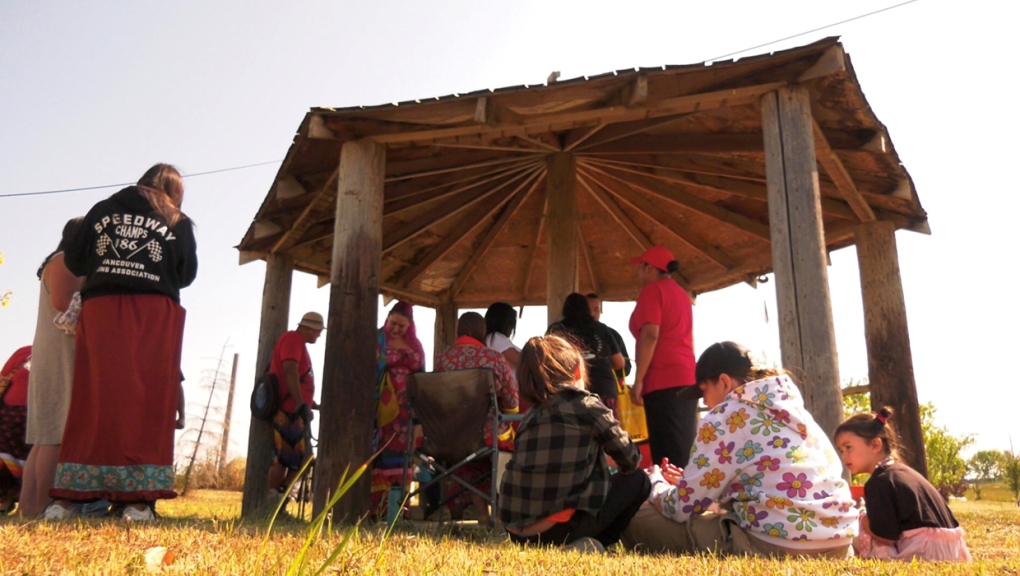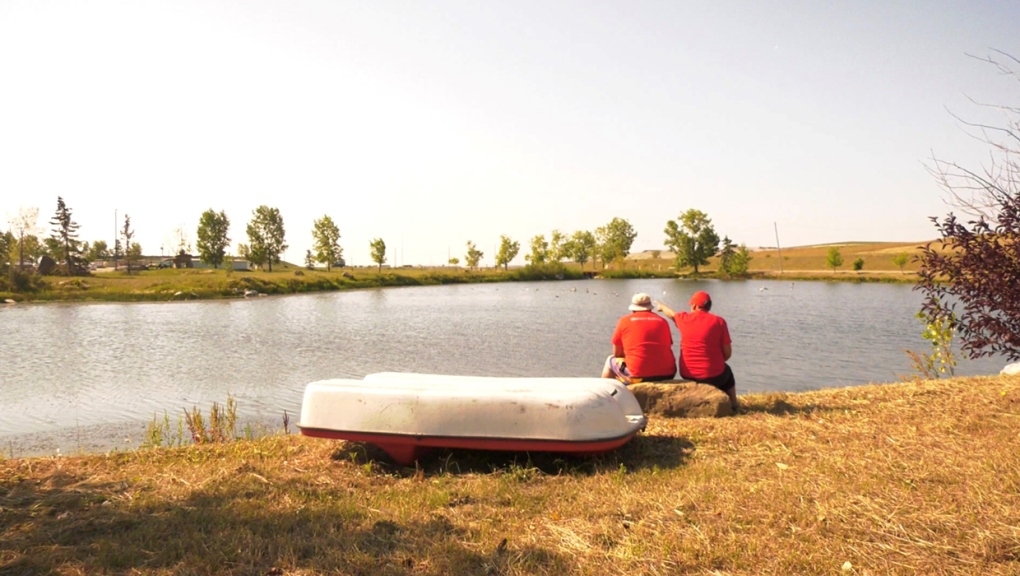Wildfire updates provided by the Northwest Territories government show that the fire increased in size over the weekend, surpassing 4,000 square kilometres between Saturday and Sunday.
As of 7 p.m. local time Monday, the fire had grown to more than 4,100 square kilometres.
Meanwhile, members of the Northwest Territories legislative assembly voted on Monday to change the date of the next general election from Oct. 3 to Nov. 14 due to the wildfires.
This comes at the recommendation of the territory's chief electoral officer, who said last week that in the absence of any legislation, the assembly would have to dissolve on Sept. 3 and elections in ridings subject to evacuation orders would be delayed for up to three months. This could result in some members being elected on different days.
The legislative assembly also voted to add another $75 million in funding for fire suppression, in addition to the $21.8 million already budgeted, bringing total spending this fiscal year potentially up to nearly $100 million.
Finance Minister Caroline Wawzonek said the fire season typically ends sometime in October.
"Nothing about this year has been typical thus far," she added. "So hopefully this will be adequate to get through to the end of that period. If not, it should at least be adequate to get through to the point that there'd be another opportunity for an assembly sitting later in the fall."
Officials stressed Monday that they are still in an emergency, but added that there are reasons for optimism.
“There were no new fires tonight or today – that’s a big one when we have as many fires as we do,” Jessica Davey-Quantick, wildfire information officer, said in the press update.
“The fire outside of Jean-Marie River is now about 80 per cent contained, even with poor visibility today in the area making it hard for our crews to get in the air.”
Jean-Marie River is one of the few communities where the evacuation order has been lifted.
YELLOWKNIFE RESIDENTS STILL UNABLE TO RETURN, BUT PLANS ARE BEING DRAWN UP
It’s still unclear when Yellowknife residents will be able to return safely, but officials laid out a five phase plan on Monday for how the process will work when the time comes.
Phase one is determining that the community is safe from wildfire. Once it is determined that the risk to the community has decreased, communities will be informed, but will not be able to return right away.
In phase two, experts will determine the level of damage to a community. Not all communities will have fire damage, while some may have significant structure damage, making this phase a longer process for some communities than others.
The first to be permitted to return will be essential personnel, who will be identified and contacted in phase three, and then will work to re-establish basic services in phase four.
“Hospitals, gas stations, groceries, those are just a few in a non-exhaustive list of examples that make the community able to support itself,” Boast said.
In phase five, the general population will be able to return, but officials are still working out how best to facilitate the return of residents who fled by air as well as who fled by vehicle. In order for residents to return by car, for instance, the roads need to be safe and there needs to be enough fuel for those making the journey.
“We may have to look at whether we stagger the dates of travel to ensure we don’t end up with congested routes that still are needed for wildfire response in other areas,” Boast said.
STILL UNKNOWN HOW MANY STRUCTURES DAMAGED IN HAY RIVER
Officials say there has been "significant damage" in the wake of the Hay River fire, particularly in the areas of Patterson Road and Paradise Gardens, located south of the town.
A Google satellite image of the area shows structures along Patterson Road and in Paradise Gardens, but officials have not been able to confirm how many have been damaged.
The flames have now crossed Highway Five between kilometres six and 20, officials said Monday, and have also reached the area of Delancey Estates.
Officials did not provide details in Monday afternoon’s update on how many structures have been damaged, but added that fire crews have been able to hold back a lot of the flames, and that no additional buildings have been lost.
“Structure protection is working, and has saved numerous structures where the fire has encroached,” Davey-Quantick said.
Mike Westwick, a fire information officer with N.W.T. Fire.ca in an interview earlier on Monday that their focus at this point is still on pushing the fire back and addressing the "hot spots" instead of detailed structural assessment.
"(We're) working to knock down any remaining heat in the area to discourage any further ignition of structures," he said.
The rapid ignition of the area was driven by 70 km/h winds over the weekend that pushed flames toward Hay River.
Westwick, who was stationed in the town, was asked to evacuate during the "unbelievable event" over the weekend along with other essential personnel.
"The day that I left — temporarily — was the day that there was a blow-up event and the fire was bearing down on town," he said. "(I could see) thick, dark orange smoke… the skies just getting darker by the minute."
Throughout the "hairy" situation people were doing "everything they can" to prevent the fire from reaching the town, he said.
There are currently more than 200 personnel and air tankers, using 21 pieces of heavy equipment with more on the way, fighting the Hay River fire. There are also 12 helicopters tackling the blaze, an increase from 10 Sunday.
FORT SMITH
Fort Smith, located near the border between the Northwest Territories and Alberta, was battling increased fire behaviour on Sunday, but saw no significant fire growth on Monday, officials say.
“That’s really good news for that fire,” Davey-Quantick said.
Heavy smoke lingering worked in firefighters’ favour, acting as an “umbrella” that prevented the fire from benefitting from sunlight. Hot temperatures are expected to continue into Tuesday and could spur more fire activity, however, and the fire is still considered out-of-control.
The Wood Buffalo Complex fire, about 3.4 km from Fort Smith and 3.1 km from Fort Fitzgerald, Alta., is more than 4,700 square kilometres in size. In the past few days, more personnel have flocked to the area.
The out-of-control wildfire has kept people from their homes for more than a week. Crews completed the Fort Smith containment line on Sunday, which is 100 metres long.
"People need to realize this is an active fire. There's still a good potential that the fire could come to the town," Caroline Charbonneau, a fire information officer with Alberta Wildfire, told CTVNews.ca in an interview on Monday.
She added that if they lose the heavy smoke cover that is keeping the temperature down and shading the ground from the sun over the next few days, the fire could see more growth.
"It keeps the temperature low and it keeps the relative humidity up," Charbonneau said.
"If we don't have that smoke, we anticipate extreme fire behaviour. It doesn't mean that the fire is going to burn toward the town, but the fire we anticipate will burn…will grow."
WHAT ARE CREWS DOING?
In some cases, firefighters work around the clock to tame wildfires in the territory.
Some of their efforts involve protecting existing structures from flames, redirecting fire pathways and dousing the blaze from the ground and air.
Heavy equipment, like bulldozers, are being used to plow guard lines, clearing fire "fuel" (dry vegetation) and creating a barrier crews can work from.
By removing trees, shrubs and grass in the area, it discourages fire growth, according to N.W.T. fire's website. These tactics are being used in the fight against wildfires across the territory.
Another tactic crews use, called tightening, is similar to a dozer guard, but instead digs away vegetation at the edge of a fire to discourage forward growth, N.W.T. fire said.
This was done on the northeast corner of the Hay River fire nearest to Kakisa. On Sunday, three kilometres of tightening was completed.
If conditions allow, workers will also ignite key portions of the land to burn in a controlled environment. Previously burned land is not good fuel for a fire and deters further growth.
An update from N.W.T. fire on Sunday said successful controlled ignition held back the fire's progress "considerably."
Structural protection involves laying hose for sprinklers and fire retardants.
"Structural firefighters worked on hotspots in fire-impacted areas and are at constant readiness for defending against additional encroachment into neighbourhoods," an update reads.
Crews also have helicopters carrying huge buckets of water to douse the fire. Those on the ground, depending on safety, also use hoses to put out fires according to an update online.




















